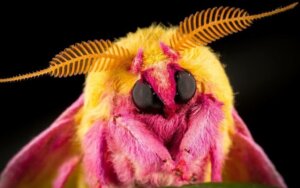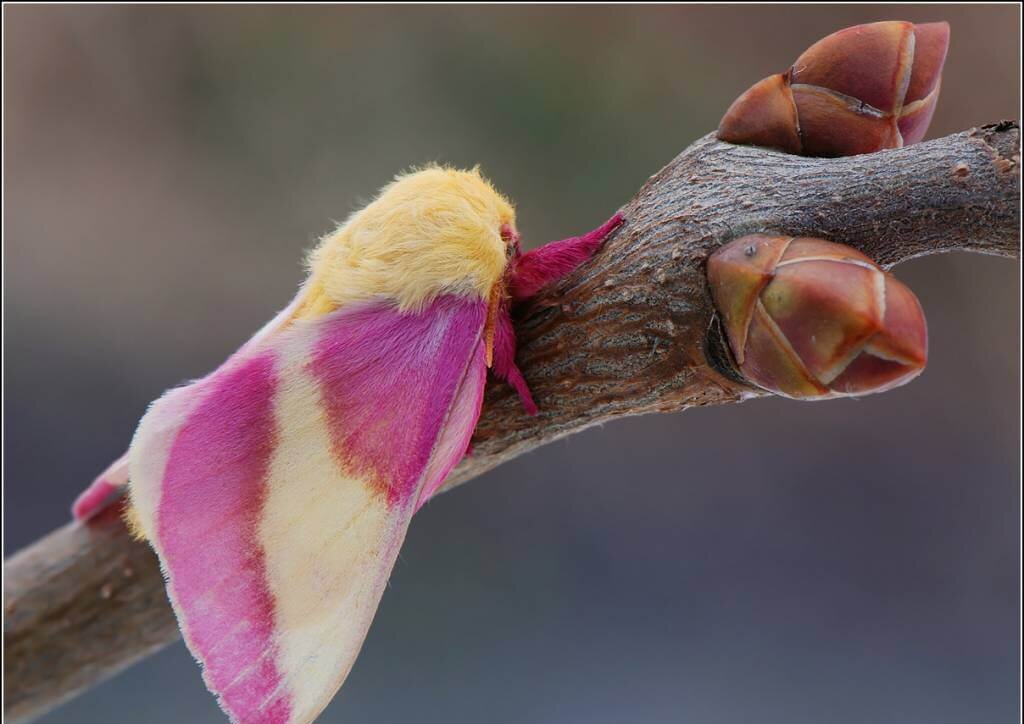Rosy Maple Moth: Habitat, Characteristics and Reproduction


Written and verified by the psychologist Sara González Juárez
This moth, although somewhat despised in its place of origin, has colors that would pique anyone’s interest. We’re talking about the rosy maple moth, which dazzles us with its caramel colors and hairy body.
Here we’ll tell you a little more about it thanks to this fact sheet on its biology. Don’t miss it, because even the smallest animals are capable of holding surprising secrets, especially those that are studied as pests and not as a member of their environment. Let’s begin.
Taxonomy and characteristics
The rosy maple moth has the scientific name Dryocampa rubicunda. This arthropod belongs to the family Saturniidae and to the genus Dryocampa, which includes 6 species in total. The one that concerns us, however, is the most colorful of this taxonomic group and, therefore, the best known.
Although the best-known image of this moth is of an adult in shades of yellow and pink, the truth is that its coloration is very variable, ranging from white with yellow markings to dark pink and more. Its woolly body and antennae are usually an intense pink color.
There’s sexual dimorphism, as males have narrower and more angular wings than females. Their antennae, moreover, are bipectinate while the females’ are simple. Females are larger, reaching 50 millimeters (2 inches) in length compared to 44 millimeters for males.
Rosy maple moth habitat
These moths are native to North America and southern Canada. They’re usually found in deciduous forests, especially where several species of maples are found: red maple (Acer rubrum), sugar maple (Acer saccharum), silver maple (Acer saccharinum), boxelder maple (Acer negundo) and turkey oak (Quercus laevis).
Rosy maple moths have also been found in suburban areas, where environmental pollution is lower.
Feeding
The adult moths don’t feed, as this is a phase specifically dedicated to reproduction. Larvae, on the other hand, are voracious and capable of consuming their host tree. They’re folivorous, so it’s easy to see them eating whole leaves and even branches.
Behavior of the rosy maple moth
These moths are nocturnal and mainly solitary, as only during the breeding season do they come together to find a mate. They usually fly during the first third of the night, when the females release pheromones to attract males.
Although it was thought that the larvae were gregarious, the truth is that they only feed together in the early stages of their development. Afterwards, they gradually become solitary animals. When they’re ready to pupate in the winter, they bury themselves in shallow holes until spring.
The main form of communication of the rosy maple moth is by smell and touch, since they don’t have very acute eyesight (even so, they do perceive ultraviolet wavelengths). The antennae, palps, and legs are where most sensory receptors are found.
Thanks to the setae (their feather-like antennae) they sense the direction of the wind while flying and are able to redirect their course.
Reproduction
The life cycle of the rosy maple moth begins with the egg that the female deposits on the inside of the maple leaves. After 2 weeks, the caterpillars hatch and group together to feed until the third molt, at which time they become more solitary.
They bury themselves for metamorphosis. Then, from May to July, the adults emerge and prepare to reproduce. Although not much is known about their mating behavior, it’s known that fertilization is internal and takes place after dusk. The following night, the females lay eggs, in groups of 10 to 30, and a total of 150-200.
Their mating system is polygynandrous, i.e. males and females mate with different individuals during the night.
The larvae will hatch 2 weeks later, restarting the cycle. In total, these moths have a life expectancy ranging from 2 to 9 months, depending on when they bury themselves to pupate.
The complicated relationship with humans

Insects are by far the most overlooked animals on our planet. Although we often admire the more colorful ones (as is the case of the rosy maple moth), we’re not too fond of the larvae. This is due to the impact that they have on maple plantations, as a single generation can completely defoliate a tree.
Therefore, there’s still a need to research and discover a way to remove them from these areas without killing them, as the caterpillars and moths of this species are still an important link in their ecosystems. Let’s look after every species on this planet, even the smallest ones!
This moth, although somewhat despised in its place of origin, has colors that would pique anyone’s interest. We’re talking about the rosy maple moth, which dazzles us with its caramel colors and hairy body.
Here we’ll tell you a little more about it thanks to this fact sheet on its biology. Don’t miss it, because even the smallest animals are capable of holding surprising secrets, especially those that are studied as pests and not as a member of their environment. Let’s begin.
Taxonomy and characteristics
The rosy maple moth has the scientific name Dryocampa rubicunda. This arthropod belongs to the family Saturniidae and to the genus Dryocampa, which includes 6 species in total. The one that concerns us, however, is the most colorful of this taxonomic group and, therefore, the best known.
Although the best-known image of this moth is of an adult in shades of yellow and pink, the truth is that its coloration is very variable, ranging from white with yellow markings to dark pink and more. Its woolly body and antennae are usually an intense pink color.
There’s sexual dimorphism, as males have narrower and more angular wings than females. Their antennae, moreover, are bipectinate while the females’ are simple. Females are larger, reaching 50 millimeters (2 inches) in length compared to 44 millimeters for males.
Rosy maple moth habitat
These moths are native to North America and southern Canada. They’re usually found in deciduous forests, especially where several species of maples are found: red maple (Acer rubrum), sugar maple (Acer saccharum), silver maple (Acer saccharinum), boxelder maple (Acer negundo) and turkey oak (Quercus laevis).
Rosy maple moths have also been found in suburban areas, where environmental pollution is lower.
Feeding
The adult moths don’t feed, as this is a phase specifically dedicated to reproduction. Larvae, on the other hand, are voracious and capable of consuming their host tree. They’re folivorous, so it’s easy to see them eating whole leaves and even branches.
Behavior of the rosy maple moth
These moths are nocturnal and mainly solitary, as only during the breeding season do they come together to find a mate. They usually fly during the first third of the night, when the females release pheromones to attract males.
Although it was thought that the larvae were gregarious, the truth is that they only feed together in the early stages of their development. Afterwards, they gradually become solitary animals. When they’re ready to pupate in the winter, they bury themselves in shallow holes until spring.
The main form of communication of the rosy maple moth is by smell and touch, since they don’t have very acute eyesight (even so, they do perceive ultraviolet wavelengths). The antennae, palps, and legs are where most sensory receptors are found.
Thanks to the setae (their feather-like antennae) they sense the direction of the wind while flying and are able to redirect their course.
Reproduction
The life cycle of the rosy maple moth begins with the egg that the female deposits on the inside of the maple leaves. After 2 weeks, the caterpillars hatch and group together to feed until the third molt, at which time they become more solitary.
They bury themselves for metamorphosis. Then, from May to July, the adults emerge and prepare to reproduce. Although not much is known about their mating behavior, it’s known that fertilization is internal and takes place after dusk. The following night, the females lay eggs, in groups of 10 to 30, and a total of 150-200.
Their mating system is polygynandrous, i.e. males and females mate with different individuals during the night.
The larvae will hatch 2 weeks later, restarting the cycle. In total, these moths have a life expectancy ranging from 2 to 9 months, depending on when they bury themselves to pupate.
The complicated relationship with humans

Insects are by far the most overlooked animals on our planet. Although we often admire the more colorful ones (as is the case of the rosy maple moth), we’re not too fond of the larvae. This is due to the impact that they have on maple plantations, as a single generation can completely defoliate a tree.
Therefore, there’s still a need to research and discover a way to remove them from these areas without killing them, as the caterpillars and moths of this species are still an important link in their ecosystems. Let’s look after every species on this planet, even the smallest ones!
All cited sources were thoroughly reviewed by our team to ensure their quality, reliability, currency, and validity. The bibliography of this article was considered reliable and of academic or scientific accuracy.
- Pickering, J. (2016). Why fly now? Pupa banks, aposematism, and other factors that may explain observed moth flight activity. S. Lep. News, 38(1), 67-72.
- Allen, D. C. (1976). Biology of the green-striped mapleworm, Dryocampa rubicunda (Lepidoptera: Saturniidae) in the northeastern United States. Annals of the Entomological Society of America, 69(5), 857-862.
- Dryocampa rubicunda (rosy maple moth). (s. f.). Animal Diversity Web. https://animaldiversity.org/accounts/Dryocampa_rubicunda/
This text is provided for informational purposes only and does not replace consultation with a professional. If in doubt, consult your specialist.








